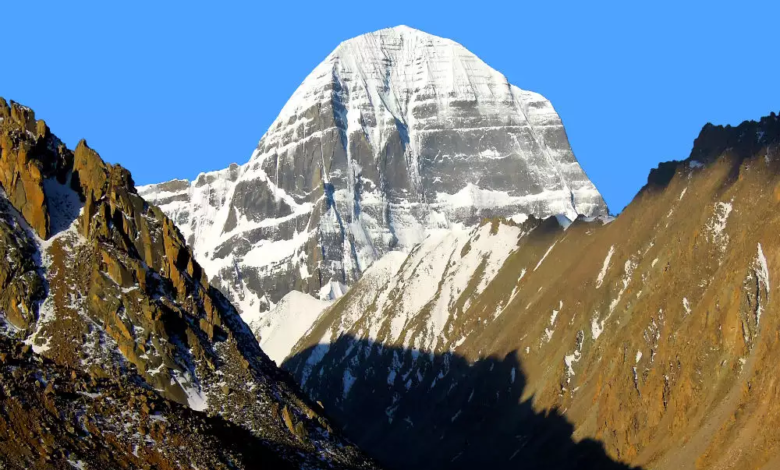
Nestled in the heart of the towering Himalayas, Mount Kailash, often referred to as the “Stairway to Heaven,” is a place of profound enigma and spiritual significance. This sacred mountain, with its awe-inspiring beauty and enigmatic aura, attracts explorers, scholars, and spiritual seekers from around the world. It is a place of intrigue, where natural phenomena and ancient legends intertwine, captivating the human imagination for centuries. Join us on a journey to unravel the secrets of Mount Kailash, peeling back its layers to reveal the extraordinary and revered aspects of this remarkable place.

Credit: Getty Images
A Sacred Site for Multiple Religions
Mount Kailash holds a unique status as a sacred site for several religions. While the specific beliefs and rituals may vary, the mountain’s spiritual significance remains a common thread. Hindus, Buddhists, Jains, and adherents of the Bon religion all hold Mount Kailash in deep reverence.
For Hindus, Mount Kailash is often associated with Lord Shiva, one of the principal deities in the Hindu pantheon. It is considered to be the physical embodiment of Mount Meru, a sacred mountain in Hindu cosmology. The legend has it that Mount Kailash is Lord Shiva’s abode, where he performs his cosmic dance of creation and destruction. Pilgrims from the Hindu faith undertake the arduous journey to Mount Kailash each year, believing that it will bring them closer to Shiva and help them attain salvation.
Buddhists, on the other hand, believe that Mount Kailash is the dwelling place of the Buddha Demchok, representing supreme bliss. Making a pilgrimage to the mountain is seen as a path to achieving nirvana, liberation from the cycle of rebirth.
Jains view Mount Kailash as the site of Rishabha Deva’s meditation, which is said to have lasted an astonishing 100 years. Rishabha Deva was the first Tirthankara (a liberated being) of Jainism, and his tapasya, or intense meditation, is central to Jain belief. Jains make the pilgrimage to Mount Kailash with the hope of achieving moksha, liberation from the cycle of rebirth.
The Bon religion, indigenous to Tibet, reveres Mount Kailash as the home of Shenlha Okar, one of their most important deities. It serves as a sacred place for their spiritual practices and rituals.

Credit: Getty Images
Discovered as the Center of the World
Mount Kailash is not only a sacred mountain but is also considered the center of the world. This belief is shared among the various religious traditions that venerate the mountain. Pilgrims from diverse backgrounds converge on the mountain each year, undertaking the challenging journey to its summit in search of spiritual enlightenment.
For Hindus, Mount Kailash is the abode of Lord Shiva, the center of their spiritual universe. It is believed that Mount Kailash is the place where Shiva meditates and grants boons to his devotees. Pilgrims perform parikrama, a ritual circumambulation of the mountain, as an act of devotion.
Buddhists consider Mount Kailash to be the home of Buddha Demchok, representing wisdom and compassion. Making a pilgrimage to the mountain is a profound spiritual experience, believed to cleanse the soul and facilitate enlightenment.
Jains believe that Mount Kailash is where their first prophet, Rishabhadeva, achieved moksha, or liberation from the cycle of birth and death. They, too, undertake pilgrimages to the mountain, seeking spiritual transformation.
The Bon religion of Tibet regards Mount Kailash as the seat of power for their supreme deity, Yungdrung Bon. Pilgrims from the Bon tradition engage in rituals and ceremonies on the mountain, connecting with their spiritual heritage.

Credit: Getty Images
A Summit Unconquerable by Humans
Mount Kailash, often hailed as the center of the universe and the abode of Lord Shiva, is an imposing presence in the Himalayas. Its peak rises to an astounding 22,028 feet (6,714 meters) above sea level. The mountain’s rugged and remote surroundings make it exceedingly challenging to reach. There are only a few routes that lead to the base of the mountain, and even fewer that extend all the way to the top. To date, no human has successfully scaled Mount Kailash’s summit. Some have come close, but they have always been turned back by strong winds or other formidable obstacles. It seems that the mountain remains unconquerable by human endeavors, serving as a testament to the power and grandeur of nature.
A Stairway Between Heaven and Earth
In Tibetan Buddhism, Mount Kailash is revered as the abode of the Buddha Demchok, representing supreme bliss. Legend has it that Milarepa, one of Tibet’s most famous saints, once meditated on the mountain for three years, three months, three days, and three nights.
Today, thousands of pilgrims from around the world make the arduous journey to Mount Kailash. The 52-kilometer kora, a ritual circumambulation around the mountain, is believed to cleanse a person of their sins. For many, it is a once-in-a-lifetime pilgrimage. But what exactly is this mysterious mountain, and why is it so revered by so many different religions?
The Enigmatic Resemblance of the Lakes to the Sun and Moon
One of the enduring mysteries surrounding Mount Kailash is the uncanny resemblance of its lakes to the sun and the moon. Manasarovar, known as the sun lake, is believed to be the birthplace of Lord Brahma, a significant deity in Hinduism. Rakshesa-tal, the moon lake, is believed to be the residence of Lord Shiva. Both lakes are surrounded by snow-capped mountains, creating a picturesque and otherworldly landscape. The origins of these lakes remain a mystery, with some suggesting a meteorite impact as a possible explanation. Regardless of their origin, these lakes are truly a sight to behold and add to the mountain’s mystical allure.

Photo courtesy: Anuradha Goya
The mysteries of Mount Kailash have captivated explorers, scientists, and mystics for centuries. While the mountain’s exact nature remains the subject of speculation, its beauty and spiritual allure continue to captivate the human spirit. Whether approached as a pilgrim, an adventurer, or a seeker of the unknown, Mount Kailash remains a testament to the wonders of our natural world and the enduring power of spirituality. As we journey deeper into this enigmatic realm, we may hope to uncover more of its secrets, gaining a richer understanding of this majestic peak that holds a sacred place in the hearts of many. Mount Kailash is a place where natural beauty and spiritual significance converge, creating an experience that lingers in the hearts and minds of all who venture there.
Read More: All that you need to know about the Kailash Mansarovar Yatra 2016
Read More: Kalpa and Kinner Kailash Range




